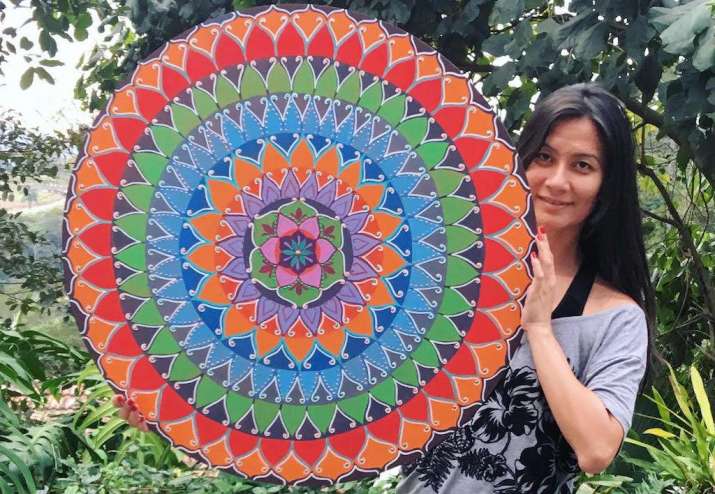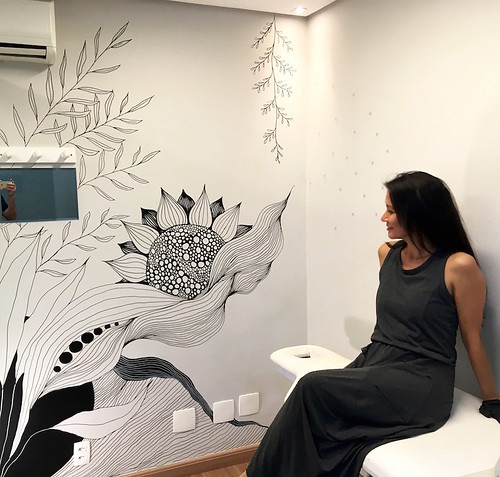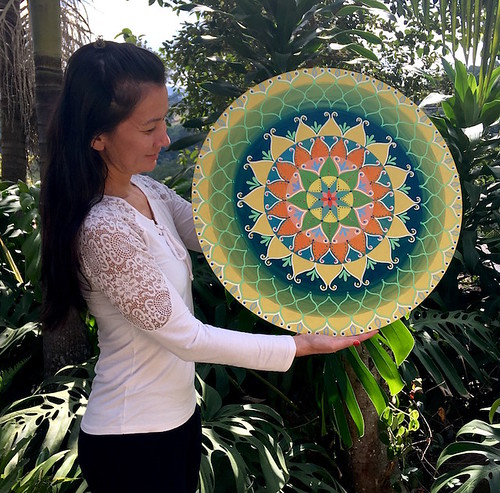FEATURES|THEMES|People and Personalities
Fabiana Nakano: Expressing Self and Universe Through a Contemporary Mandala
 Big Orange Mandala, acrylic painting. Image courtesy of Fabiana Nakano
Big Orange Mandala, acrylic painting. Image courtesy of Fabiana NakanoWhen exploring the world of contemporary spiritual art, especially art informed by Buddhist-inspired aesthetics and motifs, Latin America is an important region where creative communities are driving a conversation often unknown to the Anglophone world. Buddhism has long been a quiet undercurrent in nations such as Brazil and Argentina, mixing with already diverse Spanish and Portuguese-influenced South American cultures. Now Vajrayana Buddhism is growing modestly in countries including Argentina and Mexico, despite a deeply rooted collective Catholic identity and the rise of evangelical Christian denominations. Combine these Asian imports with Latin America’s native culture and European influences, and the outcome is a range of vibrant artistic cultures that—for now—seem characterized by eclecticism and a refusal to be defined by a particular school or discipline.
For some resident artists in Sao Paulo, Buddhism is one element of a multi-partnered conversation about making art. Many of these artists are keen to rediscover their personal heritage, and for some that involves incorporating styles such as Japanese-style watercolors into their work. These artists also see their overall aesthetic as being influenced by Asian philosophies and religions, most of which see striving for harmony with the natural universe and attunement with cosmic energies as humankind’s highest existential priority.
The contemporary mandalas of Brazilian visual artist and painter Fabiana Nakano seem to align with Western-influenced artistic disciplines inspired by certain Buddhist motifs (although, once more, definitions are limiting). These mandalas resemble cosmic blossoms and reflect an appreciation for floral symmetry, a reminder of the meticulous design of a European mosaic or the perfect dimensions of a Tibetan thangka. Colors are deployed to provide a visual harmony that draws in and pleases the eye. The mandalas have a somewhat hypnotic quality, intentionally arresting the viewer to engage emotionally and intuitively with the work rather than necessarily at a rational level.
“Nobody taught me how to draw these mandalas,” Fabiana tells me. “I learned it by myself with small sketches in my Moleskine notebook. I don’t have to envision their appearance before creating them. I only choose some colors and start the painting process from the center. I completely surrender myself while I paint mandalas. And I avoid copying mandalas, even though someone might ask me to replicate one that they like and want. I always change something and individualize the mandala.”
Born in 1979, Fabiana grew up in Sao Paulo and read architecture and urban design at Sao Paulo University: “I really love my city. It’s a complex and dynamic place, full of opportunities and also with problems, as do many big cities. I first worked in the real estate market. I used to draw and paint only as a hobby. But recently, I decided to leave my old job and become a professional artist and painter.”
Although Fabiana had long taken drawing courses, she first started by learning about artistic techniques on her own. Some of her early encouragers included Waldyr Igayara de Souza (1934–2002), a Brazilian illustrator and cartoonist who famously worked on Disney projects with Jorge Kato (1936–2011). Sao Paulo-based artist Catarina Gushiken also served as an initial mentor, and like Fabiana, possesses part-Japanese ancestry and a keen sense of her Japanese heritage.
“Waldyr Igayara taught me drawing techniques, and Catarina helped show me how to find my own inspiration and establish my own artistic expression, and Ricardo Tattoo gave me some lessons in spray and urban art,” says Fabiana. “The artists who inspire me today are so many, less well-known artists that have beautiful works in street art, and others that I follow on Instagram, such as Lanó Art, Erica Mizutani, and Tito Ferrara.”
Some of the great masters of art that she admires include Gustav Klimt (1862–1918), Frida Kahlo (1907–54), Hilma af Klint (1862–1944), a Swedish artist and mystic whose paintings were among the earliest abstract artworks predating Wassily Kandinsky (1866–1944), and Brazilian artist Emiliano Di Cavalcanti (1897–1976).
“My inspirations today are deeply connected to nature and to the feminine and female energies,” notes Fabiana. “I’m very versatile, because I’m always learning some new technique to apply. But mainly I work with acrylic, spray, and marker pens, applying them to paper, on canvas, over wood, and over walls. I can’t tell you exactly my art style, as I’m not sure exactly what it is myself, but I identify myself with abstract expressionism, land art, and street art.”
Like many other artists inspired by naturalistic philosophy and aesthetics, Fabiana combines the intellectual and theoretical with the intuitive and harmonic. “My painting happens naturally, I usually connect with my feelings and let everything go. Of course there are some forms that I like drawing. I seek these forms or movements of the hand that I appreciate more,” she tells me. “I’m always surprised when I finish my artwork because I haven’t done a project of the composition before in my head. It’s part of my creative process. I once heard Flavio Shiró [a Japanese artist born in 1928] saying in an interview exactly the same about his artwork process: that he couldn’t view it before it’s complete, because he likes to feel himself surprised.
“My art is an expression of my feelings for that moment. Most of the time I hope to bring to viewers beauty of life, nature and dreams. But I also try to go beyond. I look for something that makes me surprised or brings out a feeling of strangeness or enigma in me, like the mystery of life.”
In some ways Fabiana seems to capture, in a few honest descriptions of her art, what many eclectic artists feel about their work. They are certainly creating something distinct (these paintings are now a thing in the realm of contemporary art, regardless of their local or global fame), but their finished works continue to resist immediate or decisive categorization. That is something that reflects how traditions such as Buddhism, Daoism, or Shintoism have always resisted being bound to single-word definitions like “religion,” or “creed,” or “philosophy.” What might be an artistic equivalent of such discourses that we are still developing and debating today for Buddhism?
If we are to remain attached to words, as a species fixated with linguistics, then perhaps the word “mystery” will go some way to guiding us forward on our journey to understanding.
Related features from Buddhistdoor Global
Manifesting the Higher Self: The Mandalas of Burton Kopelow
Contemplating the Headless Buddha: The Photographic Work of Dinh Q. Lê
Beyond Gender: Seeking the Sublime in Sacred Art
Related Tea House blog posts from Buddhistdoor Global
Confessional Artists: The Buddhist Vocation of Creative Professionals
Meaning-crafting: An Emerging Discourse of Contemporary Buddhist Art

















